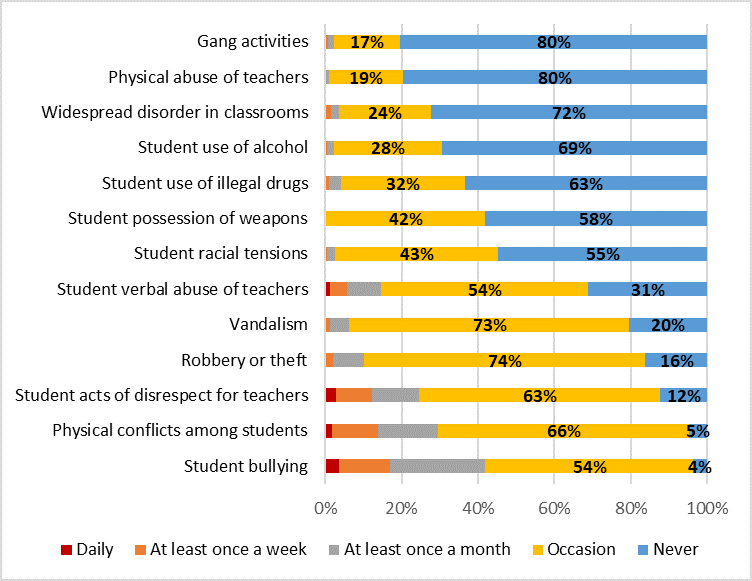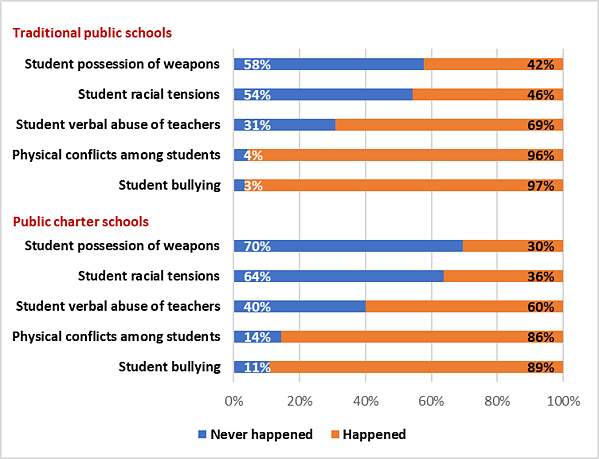This article originally was published by the National School Boards Association on October 4, 2018. It was written by Jinghong Cai, Research Analyst for the Center for Public Education (CPE), and appears below in its original entirety including the image.
Jared Black smiled on his way to school, thinking of his birthday party the next day. But the party to celebrate his 17 years in this world never happened. Jared became one of the 10 victims slain in the Santa Fe High School shooting (TX, May 18, 2018). The shooter was also 17 years old. When a school shooting occurs, parents are devastated; educators feel a surge of anxiety. Tragedies like a school shooting bring to the forefront a serious concern about issues ranging from school safety to school disciplines.
 No doubt, school safety is a huge challenge for school leaders. Some researchers state that the presence of security officers and outdoor cameras made students feel safer, but others suggest that more security may affect students psychologically and sow a seed of fear. A recent study simply concluded, “If you want your kids to be safer, try to get them into a charter school.” The study compared charter schools in New York City with their closest district school neighbors serving similar grades and reported that students in charter schools felt safer in their classrooms and hallways because they rarely saw fights, bullying, drugs or gangs. It should be noted that charter schools have special characteristics. They have smaller sizes and target specific student populations — that may contribute to fewer discipline/safety issues in charters schools than in traditional schools.
No doubt, school safety is a huge challenge for school leaders. Some researchers state that the presence of security officers and outdoor cameras made students feel safer, but others suggest that more security may affect students psychologically and sow a seed of fear. A recent study simply concluded, “If you want your kids to be safer, try to get them into a charter school.” The study compared charter schools in New York City with their closest district school neighbors serving similar grades and reported that students in charter schools felt safer in their classrooms and hallways because they rarely saw fights, bullying, drugs or gangs. It should be noted that charter schools have special characteristics. They have smaller sizes and target specific student populations — that may contribute to fewer discipline/safety issues in charters schools than in traditional schools.
To help school leaders better understand safety issues in both charter and traditional public schools, we analyzed the principal survey data collected by the U.S. Department of Education (2011-12 SASS), and investigated two questions:
- What are the top safety issues in public schools?
- How do schools keep every student safe?
Student Violence and Disrespect for Teachers
Student violence and disrespect for teachers are issues that often challenge principals when they make decisions on safety policies. According to the SASS (2011-12) data, the top three discipline/safety problems reported by principals are student bullying, physical conflicts among students, and student acts of disrespect for teachers (Figure 1). A previous study on the 2003-04 SASS data pointed out that teachers and principals in traditional public schools consistently report safety problems in their schools more often than do teachers and principals in charter schools. However, it is unclear whether the lower number of safety problems is related to specific safety policies adopted by charter schools or the characteristics of charter schools.

Figure 1: Safety and discipline problems reported by principals in 2011-12 SASS data
Our findings on these safety issues are consistent with the previous study. Among charter schools, the occurrence of students taking weapons to school, student racial tensions, and student verbal abuse of teachers is about 10 percent lower than among traditional public schools (Figure 2). Although student bullying and physical conflicts frequently happen in both charter and traditional public schools, the percentage of “never happened” for these two issues is higher among charter schools (11% and 14%) than among traditional public schools (3% and 4%). In brief, the 2011-12 SASS data show that charter schools seem to have less “trouble” than traditional public schools. However, we suggest caution when interpreting these results as only 6 percent of the schools in the studied dataset are charter schools.

Figure 2. Percentage of safety/discipline issues among charter schools and among traditional public schools in 2011-12 SASS data
Random Sweeps for Contraband or Increasing Surveillance Cameras and Presence of Police in School
As school leaders, principals of both charter and traditional public schools have many roles, but their number one priority, undoubtedly, is to keep students safe. We found some significant differences between charter schools and traditional public schools regarding the approach to school safety. After accounting for school characteristics (i.e. school size, type, level, locale, and program), charter schools are more likely to perform one or more random sweeps for contraband (e.g., drugs or weapons) excluding dog sniffs, whereas traditional public schools are more likely to require students to pass through metal detectors each day, use one or more random dog sniffs to check for drugs, and maintain a daily presence of police or security personnel.
School conditions in charter schools were also found to be significantly different from those in traditional public schools. Charter schools are more likely to be urban, secondary level, and have special programs (such as STEM and world language). By contrast, traditional public schools are more diverse than charter schools in terms of school size, school types, and programs, as well as student demographics. This finding suggests that principals may choose different safety approaches based on their school conditions.
In brief, charter schools and traditional public schools have clearly different conditions that, to a certain extent, may dictate the different approaches to safety and discipline. Further study is warranted to determine which approaches, regardless of school condition, work best for specific problems. In the end, the ultimate goal of both, charter or traditional, is to ensure a safe learning environment for every student.
